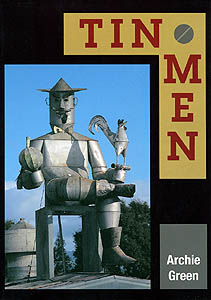|
Muffler Men by Timothy Corrigan Correll and Patrick Arthur Polk, University Press of Mississippi, 116 pages, black-and-white illustrations and color plates, 2000. ISBN 1-57806-299-3
Archie Green, a retired professor of English and folklore, is interested in a vernacular legacy that is as much social as aesthetic, but like 20th Century roadside vernacular, also on the verge of disappearing. The tin men that fascinate him are the products of skilled tradesmen, often made under the auspices of labor union apprentice programs. From an aesthetic perspective, these artifacts are mostly free of the confusion and ambivalence around training and self-consciousness that surround so much outsider and contemporary folk art. This is work made by skilled craftsmen whose training is entirely irrelevant to artistic, or even expressive, intent. These figures of heating ducts and sheet metal are made mostly for instrumental purposes - either as advertising for metalwork businesses or to demonstrate an individual's craftsmanship. The language, and by extension the art, is vernacular in the strict sense. That is to say, it actually speaks in a popular, as opposed to eccentric, dialect. Tin men are interesting in part because they are not art brut masquerading under a populist label. When their creators do attempt to express something beyond mechanical skill, they typically draw on vernacular, rather than idiosyncratic, sources to give their pieces character. The Tin Woodsman of the Wizard of Oz and science fiction robots are common, indeed obvious, points of reference for the metalworker trying to impart personality to a sculpture. None of this makes the figures mundane. Green's book includes examples of work that are just demonstrations of ability, including the tin lanterns that seems to compete with people as favored subjects in apprentice workshops. What makes the tin men and women interesting are their creators' efforts to represent the human figure absent the training in artistic effect that facilitates such representation. Green displays a nice appreciation of the workers, looking beyond purely artistic considerations (appropriately, given that art is not typically their motive) to the social and economic. But while he badly wants tin men to say something compelling, he is cautious when it comes to extracting clear messages, other than pride in one's work. He certainly avoids getting caught up in the semantic question of how to label this material -- folk, outsider, etc.? But he does ponder the distinction between tin men made as trade signs or apprentice projects and tin men built on order for an art dealer or collector, as well as the effect of a tin man being bought, removed from the storefront or shop floor and put in an artistic setting. There may be little or no sculptural distinction among these pieces, but the change in context has significance. Akin to putting a wild animal into a zoo, migration to a collection may be the best or only way to preserve the work and gain it a wider audience, but the tin men lose some of their meaning when they lose their landscape. Green also considers the self-consciousness of the creators, in particular those whose talent has brought them into contact with the art world. "I have met many skilled craftsmen who are fully aware of their creative talents, yet they remain uncomfortable when tagged as "folk artist" or "modern sculptor" and usually avoid both terms," he writes. "For some, the word folk seems to connote crudity, simplicity, and lack of command in trade discipline. At the other pole, the word sculptor seems to imply strange vision, artificiality and an inability to make a living." Unfortunately, Green's musings on how the meaning of an artifact changes with its context, from trade sign to private collection to museum, seem unfinished. Awash with portentous language that sometimes over thinks the issues involved, the book winds up feeling vague and inconclusive, the text not doing justice to the wonderful pieces of art it illustrates. Muffler Men explores a territory similar to Green's, but it is the trade signs and whimsy figures made by the guys in muffler shops rather than metalworking establishments. Indeed, the figures are so close in purpose and effect that only the materials distinguish them at first glance. (Ultimately, the metalworkers' training gives their work an edge in craftsmanship, if not creativity.) Muffler Men is a more richly designed book than Tin Men, and more tightly edited, but for one major flaw. The text is larded with dissertation-style footnotes. Statements of the obvious are constantly referenced to some prior authorized source. Original thoughts are diminished by being yoked to obscure, but footnoted, points by scholars working on entirely different subjects. It's especially odd since the book is otherwise so clearly geared to a popular audience.
A version of this review originally appeared in The Outsider magazine, published by Intuit: The Center for Intuitive and Outsider Art.
|
The Latest Stuff | Roadside art | Outsider pages | The idea barn | About | Home
Copyright Interesting Ideas 2002
